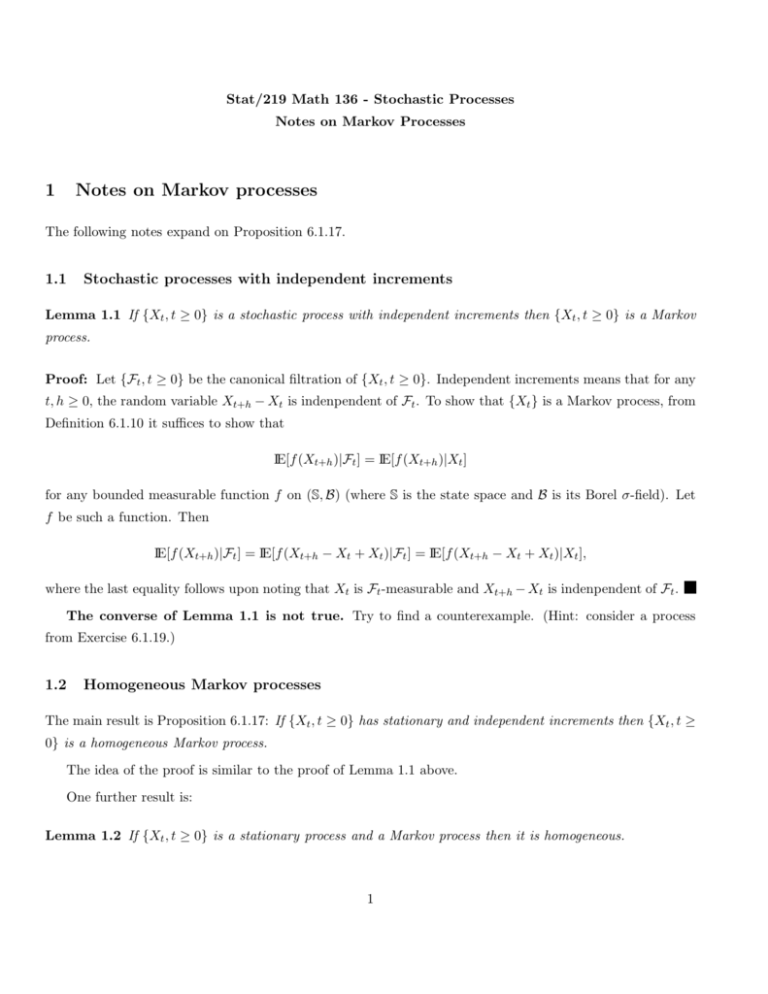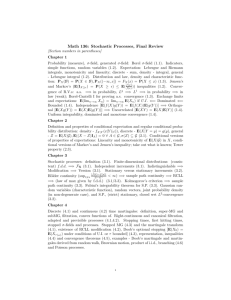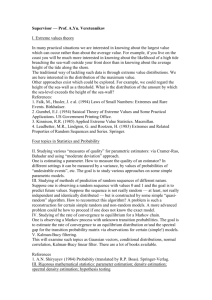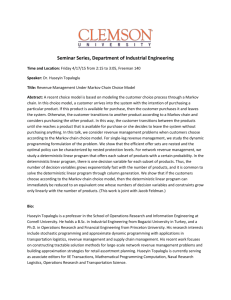1 Notes on Markov processes
advertisement

Stat/219 Math 136 - Stochastic Processes
Notes on Markov Processes
1
Notes on Markov processes
The following notes expand on Proposition 6.1.17.
1.1
Stochastic processes with independent increments
Lemma 1.1 If {Xt , t ≥ 0} is a stochastic process with independent increments then {Xt , t ≥ 0} is a Markov
process.
Proof: Let {Ft , t ≥ 0} be the canonical filtration of {Xt , t ≥ 0}. Independent increments means that for any
t, h ≥ 0, the random variable Xt+h − Xt is indenpendent of Ft . To show that {Xt } is a Markov process, from
Definition 6.1.10 it suffices to show that
IE[f (Xt+h )|Ft ] = IE[f (Xt+h )|Xt ]
for any bounded measurable function f on (S, B) (where S is the state space and B is its Borel σ-field). Let
f be such a function. Then
IE[f (Xt+h )|Ft ] = IE[f (Xt+h − Xt + Xt )|Ft ] = IE[f (Xt+h − Xt + Xt )|Xt ],
where the last equality follows upon noting that Xt is Ft -measurable and Xt+h − Xt is indenpendent of Ft .
The converse of Lemma 1.1 is not true. Try to find a counterexample. (Hint: consider a process
from Exercise 6.1.19.)
1.2
Homogeneous Markov processes
The main result is Proposition 6.1.17: If {Xt , t ≥ 0} has stationary and independent increments then {Xt , t ≥
0} is a homogeneous Markov process.
The idea of the proof is similar to the proof of Lemma 1.1 above.
One further result is:
Lemma 1.2 If {Xt , t ≥ 0} is a stationary process and a Markov process then it is homogeneous.
1
Proof: We only show here the case of a discrete time, countable state process {Xn }. Note that by stationarity,
Xn has the same distribution as X0 and (Xn+1 , Xn ) has the same distribution as (X1 , X0 ). Thus
IP(Xn+1 = y|Xn = x) =
IP(X1 = y, X0 = x)
IP(Xn+1 = y, Xn = x)
=
= IP(X1 = y|X0 = x),
IP(Xn = x)
IP(X0 = x)
which shows that the transition probabilities do not depend on n, i.e. the chain is homogeneous.
Note that in Lemma 1.2 we assumed that process itself is stationary, which is a stronger assumption than
just having stationary increments. The following example illustrates why stationary increments is not enough.
If a Markov process has stationary increments, it is not necessarily homogeneous. Consider
the Brownian bridge Bt = Wt − tW1 for t ∈ [0, 1]. In Exercise 6.1.19 you showed that {Bt } is a Markov process
which is not homogeneous. We now show that it has stationary increments. Since {Bt } is a Gaussian process
(see Exercise 5.1.7) the random variable Bt+h − Bt = Wt+h − Wt − hW1 is Gaussian (for 0 ≤ t ≤ t + h ≤ 1).
It suffices to show that its mean and variance do not depend on t. Clearly it has mean 0. Also,
IE|Bt+h − Bt |2 = IE|Wt+h − Wt |2 + h2 IE|W1 |2 − 2hIE[(Wt+h − Wt )W1 ] = h + h2 − 2h(h) = h − h2 .
Note that {Bt } does not have independent increments (which you should check).
The next example shows that the converse to Lemma 1.2 is not true. The example actually shows that
homogeneity does not imply stationary increments from which it follows that the converse to Lemma 1.2 is
not true (since any stationary process must have stationary increments.)
If a Markov process is homogeneous, it does not necessarily have stationary increments.
Consider state space S = {0, 1, 2, . . .}, initial distribution π with π({0}) = 1, and stationary transition
probability function: p({1}|0) = 1 and for x ∈ S \ {0},
1
, A = {x + 1},
x+1
x
p(A|x) = x+1
, A = {x − 1},
0,
otherwise.
Then there exists on some probability space (Ω, F, IP) a discrete homogeneous Markov chain {Xn , n =
0, 1, 2, . . .} with state space S, intial distribution π (i.e. IP(X0 = 0) = 1) and transition function p(A|x),
i.e. IP(Xn+1 ∈ A|Fn ) = p(A|Xn ) a.s., where {Fn } is the canonical filtration of {Xn }. Note that since
IP(X0 = 0) = 1 we have
X
X
IP(X1 = 1) =
IP(X1 = 1|X0 = x)IP(X0 = x) =
p({1}|x)IP(X0 = x) = p({1}|0) = 1.
x∈S
x∈S
It follows that IP(X1 − X0 = 1) = 1. Also, again since IP(X1 = 1) = 1, we have
X
X
IP(X2 − X1 = 1) =
IP(X2 − X1 = 1|X1 = x)IP(X1 = x) =
p({x + 1}|x)IP(X1 = x) = p({2}|1) = 1/2.
x∈S
x∈S
2
Thus X1 −X0 does not have the same distribution as X2 −X1 and so {Xn } does not have stationary increments.
Intuitively, if a Markov process {Xt } is homogeneous, then the conditional distribution of Xt+h − Xt given
Xt does not depend on t. Conditional on Xt , Xt is treated like a known constant so all the randomness is
given by the change from the known value Xt to the uncertain value Xt+h . The same is not necessarily true
for the unconditional distribution of Xt+h − Xt in which Xt itself is random and has a distribution which
might depend on t (even if {Xt } has stationary increments).
1.3
Showing that a stochastic process is a Markov process
We have seen three main ways to show that a process {Xt , t ≥ 0} is a Markov process:
1. Compute IP(Xt+h ∈ A|Ft ) directly and check that it only depends on Xt (and not on Xu , u < t).
2. Show that the process has independent increments and use Lemma 1.1 above.
3. Show that it is a function of another Markov process and use results from lecture about functions of
Markov processes (e.g. if f is invertible and {Yt } is a Markov process then {f (Yt )} is a Markov process).
3








